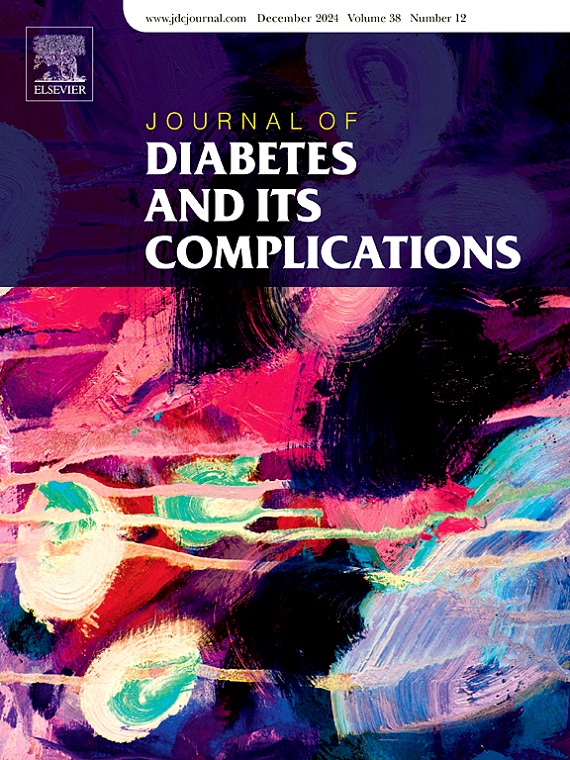Associations of time in range and glycemic risk index with insulin resistance and diabetic kidney disease in patients with type 2 diabetes
IF 3.1
3区 医学
Q3 ENDOCRINOLOGY & METABOLISM
引用次数: 0
Abstract
Aims
Effective glycemic control is essential for preventing complications and improving quality of life in patients with type 2 diabetes mellitus (T2DM). Identifying reliable glycemic indicators for the assessment of islet function and renal complications remains a major challenge in diabetology. Time in Range (TIR) and Glycemia Risk Index (GRI), two continuous glucose monitoring (CGM)-based metrics, have recently emerged as potential tools for assessing glycemic control beyond HbA1c. This study aims to assess the predictive value of TIR and GRI for islet function impairment and diabetic kidney disease (DKD) in patients with T2DM.
Methods
A retrospective analysis of a total of 422 patients with T2DM was performed, who were admitted to Zhuhai People's Hospital between January 2021 and December 2022. Continuous glucose monitoring (CGM) data were collected to get TIR and GRI. Additionally, the C-peptide release, random urine biochemistry analysis, and C-reactive protein (CRP) were obtained to calculate HOMA-IR, HOMA-β, ISIstumvoll index, Stumvoll 1-phase and 2-phase index, and insulin resistance. The Urinary Albumin/Creatinine Ratio (UACR) was ascertained as a diagnostic marker of DKD.
Results
TIR and GRI demonstrated significant correlations with HOMA-IR, HOMA-β, and UACR; however, CRP exhibited a limited correlation with HOMA-IR and UACR. After adjustment for potential confounding factors, the odds ratios (ORs) for pancreatic β-cell function were: TIR 0.174 (95 % CI 0.051–0.592), GRI 1.010 (95 % CI 1.001–1.020). For DKD: TIR 0.182 (95 % CI 0.052–0.639), GRI 1.017 (95 % CI 1.007–1.027). TIR levels of 71 %–85 % and 41 %–70 % were associated with a 4.763-fold and 5.079-fold higher risk of insulin resistance, respectively, compared with TIR > 85 %. Similarly, GRI levels of 21–30, 31–45, and 46–100 were associated with 2.553-fold, 2.597-fold, and 3.394-fold increases in insulin resistance risk compared with GRI ≤20. Despite excluding CRP, TIR and GRI differences in DKD and islet function were significant (P < 0.05). In the regression analysis of DKD and islet function, excluding the CRP, TIR and GRI groups, the differences remained statistically significant (P < 0.05).
Conclusion
TIR was identified as a protective factor for pancreatic β-cell function, while GRI was associated with an increased risk of dysfunction. Furthermore, longer disease duration, higher HbA1c, elevated BMI, high GRI, and low TIR were associated with increased insulin resistance. A higher GRI and lower TIR also contributed to an elevated risk of DKD.
时间范围和血糖危险指数与2型糖尿病患者胰岛素抵抗和糖尿病肾病的关系
目的有效控制血糖对于预防2型糖尿病(T2DM)患者并发症和改善生活质量至关重要。确定可靠的血糖指标来评估胰岛功能和肾脏并发症仍然是糖尿病学的一个主要挑战。范围时间(TIR)和血糖风险指数(GRI)是两种基于连续血糖监测(CGM)的指标,最近成为评估HbA1c以外血糖控制的潜在工具。本研究旨在评估TIR和GRI对T2DM患者胰岛功能损害和糖尿病肾病(DKD)的预测价值。方法对珠海市人民医院2021年1月至2022年12月收治的422例T2DM患者进行回顾性分析。采集连续血糖监测(CGM)数据,获得TIR和GRI。此外,获取c肽释放量、随机尿液生化分析和c反应蛋白(CRP),计算HOMA- ir、HOMA-β、ISIstumvoll指数、Stumvoll 1期和2期指数以及胰岛素抵抗。尿白蛋白/肌酐比值(UACR)被确定为DKD的诊断指标。结果stir、GRI与HOMA- ir、HOMA-β、UACR呈显著相关;然而,CRP与HOMA-IR和UACR的相关性有限。校正潜在混杂因素后,胰腺β细胞功能的比值比(or)为:TIR 0.174 (95% CI 0.051-0.592), GRI 1.010 (95% CI 1.001-1.020)。对于DKD: TIR 0.182 (95% CI 0.052-0.639), GRI 1.017 (95% CI 1.007-1.027)。与TIR水平相比,71% - 85%和41% - 70%的胰岛素抵抗风险分别增加了4.763倍和5.079倍。85%。同样,与GRI≤20相比,21-30、31-45和46-100的GRI水平与胰岛素抵抗风险增加2.553倍、2.597倍和3.394倍相关。尽管排除CRP,但TIR和GRI在DKD和胰岛功能方面的差异具有统计学意义(P <;0.05)。在DKD与胰岛功能的回归分析中,排除CRP、TIR、GRI组,差异仍有统计学意义(P <;0.05)。结论tir是胰腺β细胞功能的保护因子,而GRI与功能障碍风险增加相关。此外,病程延长、HbA1c升高、BMI升高、GRI高、TIR低与胰岛素抵抗增加相关。较高的GRI和较低的TIR也会增加DKD的风险。
本文章由计算机程序翻译,如有差异,请以英文原文为准。
求助全文
约1分钟内获得全文
求助全文
来源期刊

Journal of diabetes and its complications
医学-内分泌学与代谢
CiteScore
5.90
自引率
3.30%
发文量
153
审稿时长
16 days
期刊介绍:
Journal of Diabetes and Its Complications (JDC) is a journal for health care practitioners and researchers, that publishes original research about the pathogenesis, diagnosis and management of diabetes mellitus and its complications. JDC also publishes articles on physiological and molecular aspects of glucose homeostasis.
The primary purpose of JDC is to act as a source of information usable by diabetes practitioners and researchers to increase their knowledge about mechanisms of diabetes and complications development, and promote better management of people with diabetes who are at risk for those complications.
Manuscripts submitted to JDC can report any aspect of basic, translational or clinical research as well as epidemiology. Topics can range broadly from early prediabetes to late-stage complicated diabetes. Topics relevant to basic/translational reports include pancreatic islet dysfunction and insulin resistance, altered adipose tissue function in diabetes, altered neuronal control of glucose homeostasis and mechanisms of drug action. Topics relevant to diabetic complications include diabetic retinopathy, neuropathy and nephropathy; peripheral vascular disease and coronary heart disease; gastrointestinal disorders, renal failure and impotence; and hypertension and hyperlipidemia.
 求助内容:
求助内容: 应助结果提醒方式:
应助结果提醒方式:


